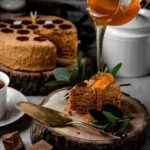When it comes to cake decoration, thick pudding is truly a game-changer. The importance of having a thick pudding for cake decoration cannot be overstated. It not only enhances the overall visual appeal of the cake but also adds a delightful creamy texture that perfectly complements the moistness of the cake layers.
Thick pudding offers a myriad of benefits and showcases its versatility in creative cake designs. Its ability to hold intricate shapes and patterns elevates the beauty of any cake, making it a showstopper at any occasion. Whether you’re designing an elegant wedding cake or a whimsical birthday creation, thick pudding is the secret ingredient you need.
But what exactly makes thick pudding so essential for cake decoration? First and foremost, its thickness provides stability, allowing it to withstand the weight of other decorations such as fondant or fresh fruit without losing its shape. Additionally, thick pudding acts as an adhesive, helping other decorations adhere securely to the cake surface.
Not only does thick pudding serve a structural purpose, but it also enhances the flavors and presentation of your cake. With various flavors available, such as chocolate, vanilla, or fruit-based options like strawberry or lemon, you can easily find the perfect match for your cake’s flavor profile. The smooth and velvety texture of thick pudding creates an irresistible contrast against the softness of the cake layers.
To achieve this extraordinary level of masterpiece in your cakes, it all starts with making the perfect thick pudding from scratch. In the following sections, we will guide you through everything you need to know – from selecting the essential ingredients to creating impeccable designs using different techniques – so you can take your cake decorating skills to new heights by using thick pudding as your go-to decoration tool.
Get ready to impress with stunning cakes that not only taste divine but also look visually breathtaking.
The Essential Ingredients for Making Thick Pudding
To make thick pudding for cake decoration, you will need a few essential ingredients. These ingredients not only contribute to the pudding’s texture but also enhance its flavor and overall appeal. Here is a breakdown of the key ingredients required and their purpose in creating the perfect thick pudding:
- Cornstarch: Cornstarch is the primary thickening agent in pudding recipes. It helps create a smooth and thick consistency by absorbing moisture and forming a gel-like structure.
- Milk: Milk is the base liquid for pudding and adds creaminess and richness to the dessert. Whole milk or heavy cream is preferred for a thicker and more indulgent pudding.
- Sugar: Sugar adds sweetness to balance out the other flavors in the pudding. It also aids in achieving a smooth texture by preventing clumping of the cornstarch.
- Egg yolks: Adding egg yolks to the pudding mixture contributes to its richness and gives it a velvety smoothness. The proteins in egg yolks help stabilize the pudding, resulting in a thicker consistency.
- Flavorings: Depending on your preference, you can add various flavorings such as vanilla extract, chocolate, fruit extracts, or liqueurs to enhance the taste of your thick pudding.
When selecting ingredients for making thick pudding, it’s important to choose high-quality items for optimal results. Fresh milk and eggs will contribute to a richer flavor, while using pure extracts or real fruits will yield more intense flavors. Additionally, using organic or locally sourced ingredients can elevate the overall quality of your cake decoration.
| Ingredient | Purpose |
|---|---|
| Cornstarch | Primary thickening agent that creates a smooth and thick consistency. |
| Milk | Base liquid that adds creaminess and richness to the pudding. |
| Sugar | Provides sweetness and prevents clumping of cornstarch for a smooth texture. |
| Egg yolks | Adds richness, velvety smoothness, and stabilizes the texture. |
| Flavorings | Enhance taste through various options like vanilla extract, chocolate, fruit extracts, or liqueurs. |
Step-by-Step Guide on Making Thick Pudding
Making thick pudding for cake decoration is a fun and rewarding process that can elevate the overall appearance and taste of your cakes. This section will provide you with a step-by-step guide on how to make thick pudding that is perfect for cake decoration.
Step 1: Gathering Your Ingredients
Before you begin making your thick pudding, gather all the necessary ingredients. The key ingredients for making thick pudding include milk, sugar, cornstarch, eggs, butter, and vanilla extract. Each ingredient plays a crucial role in achieving the desired consistency and texture of the pudding.
Step 2: Preparing the Pudding Mixture
Once you have gathered your ingredients, it’s time to prepare the pudding mixture. Start by combining sugar, cornstarch, and a pinch of salt in a saucepan. In a separate bowl, whisk together milk and egg yolks until well combined. Gradually add the milk mixture to the dry ingredients in the saucepan while stirring continuously.
Step 3: Cooking the Pudding Mixture
Place the saucepan over medium heat and cook the mixture while stirring constantly. As it heats up, you will notice it beginning to thicken. Continue cooking until the mixture reaches a full boil. Boil for approximately one minute while continuing to stir.
| Ingredients | Purpose | Effect on Texture |
|---|---|---|
| Milk | Main liquid component; adds creaminess | Creates a smooth and silky texture |
| Sugar | Sweetens the pudding; enhances flavor | Contributes to the thickness and viscosity |
| Cornstarch | Thickening agent; stabilizes the pudding | Gives pudding its thick and creamy consistency |
| Eggs | Provides richness and a velvety texture | Helps in binding and thickening the pudding |
| Butter | Adds richness and enhances flavor | Makes the pudding creamier and smoother |
Tips for Achieving the Desired Thickness and Consistency
- Stir continuously: Constant stirring prevents lumps from forming and ensures even cooking.
- Cook until it coats the back of a spoon: To check if the pudding is thick enough, dip a spoon into the mixture, then run your finger over the back of the spoon. If it leaves a distinct trail, your pudding is ready.
- Chill to thicken further: If after cooking, you find that your pudding is not as thick as desired, you can refrigerate it for a couple of hours to allow it to firm up.
By following this step-by-step guide, you will be able to create a deliciously thick pudding that is perfect for cake decoration. The next section will explore different flavor combinations for your thick pudding, allowing you to further enhance your cake decorating skills.
Choosing the Right Flavor Combinations for Thick Pudding Decoration
Choosing the right flavor combinations for thick pudding decoration is crucial in creating a cake that not only looks visually appealing but also tastes delightful. With a wide range of flavor options available, it can be challenging to decide which one would best complement your cake. This section will explore different flavor options for the pudding, provide suggestions on pairing flavors with the cake’s profile, and offer tips on creating unique and complementary flavor combinations.
Exploring Different Flavor Options
When it comes to choosing a flavor for your thick pudding decoration, the possibilities are endless. Some popular options include chocolate, vanilla, and fruit-based flavors like strawberry or mango. Each flavor can bring its own unique element to the overall taste of the cake. Chocolate pudding can add richness and depth, while vanilla provides a classic and versatile option. Fruit-based flavors can introduce a refreshing twist and pair well with fruity or citrusy cakes.
Pairing Pudding Flavors with Cake Profile
To achieve a harmonious blend of flavors, it is important to consider the profile of your cake when choosing the pudding flavor. For example, if you have a chocolate cake as the base, pairing it with a chocolate-flavored thick pudding can intensify the chocolate experience. On the other hand, if you have a light and fluffy vanilla or lemon-flavored cake, a fruit-based pudding like strawberry or passionfruit can add an interesting contrast.
Creating Unique Flavor Combinations
One of the exciting aspects of using thick pudding for cake decoration is that you have endless opportunities to create unique and complementary flavor combinations. Consider experimenting with unexpected pairings like coffee-flavored pudding on a caramel or mocha cake. You can also layer different flavored puddings to create new taste sensations within the same slice of cake. The key is to balance the flavors so that they enhance each other without overpowering any individual taste.
By carefully selecting the right flavor combinations, you can elevate your cake decoration skills and create a cake that not only looks visually appealing but tastes absolutely delicious. Don’t be afraid to think outside the box and try new and inventive flavor pairings. The possibilities are endless, and with a thick pudding as your canvas, you have the opportunity to create a truly unique and memorable cake.
Techniques to Achieve Impeccable Pudding Decoration
When it comes to cake decoration, the techniques used can make all the difference in achieving a visually stunning result. Pudding is not only delicious but can also be a great medium for creating intricate and eye-catching designs on cakes. In this section, we will explore various techniques that you can use to achieve impeccable pudding decoration.
Demonstrating Various Application Methods
One of the first things to consider when decorating a cake with thick pudding is how it will be applied to the surface. There are several methods that can be used depending on the desired design and effect. One popular technique is using a piping bag with different tips to create various shapes and patterns. This allows for precise control over the placement of the pudding and enables you to create intricate designs like rosettes, waves, or borders.
Alternatively, you can also use a spatula or an offset spatula to spread the pudding onto the cake’s surface. This technique is great for achieving smooth finishes or creating larger areas of decoration. You can experiment with different textures by using different spatula motions such as swirling or stippling.
Tools for Precision and Intricate Designs
To achieve more complex and detailed designs, it’s important to have the right tools on hand. Piping bags with different tips allow for more control when applying pudding and can be used to create fine lines, dots, or even written messages on the cake’s surface.
If you prefer a more freehand approach, small squeeze bottles with narrow nozzles can be filled with pudding for precision decorating. These bottles allow you to draw directly onto the cake without worrying about your hand shaking or losing control.
Additionally, stencils are another useful tool for achieving intricate designs. Simply place a stencil onto the cake’s surface and use a sifter or shaker filled with cocoa powder or colored sugar to create a pattern. This technique works especially well if you want to achieve a delicate lace or filigree effect.
Creating Dimension and Texture
To take your pudding decoration to the next level, consider adding dimension and texture to your design. One way to do this is by adding different layers of pudding with contrasting colors or flavors. For example, you can create ombre effects by layering different shades of the same color, or opt for a multi-colored design with complementary flavors.
Another technique for creating dimension is through the use of drizzles or frosting accents. You can melt some chocolate and drizzle it over the cake in a zigzag pattern, or use a piping bag with a small round tip to add dots or small swirls of frosting on top of the pudding decoration. This will not only add visual interest but also provide additional texture to your cake.
By utilizing these techniques and tools, you can achieve impeccable pudding decoration that will elevate your cake to new heights. The combination of precise application methods, precise tools, and added dimension will result in an eye-catching creation that is sure to impress both visually and taste-wise. So don’t be afraid to experiment and let your creativity shine through.
Incorporating Color to Enhance Pudding Decoration
Color plays a vital role in enhancing the visual appeal of any cake decoration, and pudding is no exception. By incorporating color into your pudding decoration, you can create stunning and eye-catching designs that will take your cake to the next level. Here are some techniques and tips to help you achieve vibrant and visually appealing pudding decorations:
- Using Food Coloring: One of the easiest ways to add color to your pudding is by using food coloring. Whether you want bold and vibrant tones or soft pastel hues, food coloring allows you to customize the color of your pudding according to your preference. Start with a small amount of coloring and gradually add more until you achieve the desired shade.
- Creating Ombre Effects: Ombre effects involve blending different shades of the same color together, creating a gradient effect from light to dark. To create an ombre effect in your pudding decoration, divide the prepared pudding mixture into several bowls and gradually add varying amounts of food coloring to each bowl. Layer the different shades on top of each other for a beautiful ombre effect when decorating your cake.
- Multi-Colored Designs: Another way to enhance your pudding decoration is by creating multi-colored designs. Divide the prepared pudding mixture into separate bowls and add different colors of food coloring to each bowl. Use piping bags or spatulas to apply the different colored puddings onto your cake, either in distinct patterns or as intricate designs.
When working with colored puddings, it’s important to remember that consistency matters. If adding liquid food coloring affects the thickness of your pudding, consider using gel-based or powdered food coloring instead for better control over the texture.
By incorporating color into your thick pudding decoration, you can transform a simple cake into a visually stunning masterpiece. So don’t be afraid to experiment with different colors, techniques, and design ideas to create unique and personalized creations that will impress your guests.
Remember to have fun and let your creativity shine through as you elevate your cake decorating skills with thick pudding.
Taking Pudding Decoration to the Next Level
One of the most exciting aspects of using thick pudding for cake decoration is the opportunity to take it to the next level by adding various toppings and textures. These additional elements not only enhance the overall visual appeal of the cake but also provide a delightful sensory experience for those enjoying it. Here are some tips and techniques to help you elevate your pudding decoration with toppings and textures:
- Toppings for added texture: Sprinkles, chopped nuts, or cookie crumbs are popular choices when it comes to adding texture to a cake with thick pudding decoration. Sprinkles add a fun and colorful touch, while chopped nuts or cookie crumbs provide a crunchy element that contrasts nicely with the smoothness of the pudding.
- Edible flowers and fruit slices for freshness: Adding edible flowers or slices of fresh fruit can bring a refreshing touch to your cake’s presentation. Not only do they add visual interest, but they also contribute natural flavors that complement the taste of the pudding.
- Dimension with drizzles and frosting accents: To create additional dimension in your pudding decoration, consider incorporating chocolate drizzles or frosting accents. Drizzling melted chocolate over the pudding surface creates an elegant effect, while frosting accents can be used to highlight specific design elements or create intricate patterns.
When adding toppings and textures to your pudding-decorated cake, it’s essential to consider complementary flavors and visual aesthetics. The choice of toppings should complement both the flavor profile of the pudding and the overall theme or style of the cake.
To ensure proper storage and freshness of your decorated cake, it’s best to keep it refrigerated if it contains perishable ingredients like fruits or creams. However, if you have non-perishable toppings such as sprinkles or chopped nuts, cover the cake loosely with plastic wrap or place it in an airtight container at room temperature.
Experimentation is key when it comes to selecting toppings and creating unique texture combinations for your pudding-decorated cake. Don’t be afraid to let your creativity shine and explore different flavor and texture combinations to create a visually stunning and delicious treat. With the right toppings and textures, you can truly take your pudding decoration skills to the next level.
Serving and Storing Tips for Pudding Decorated Cakes
Once you have put in the effort to decorate your cake with thick pudding, it is important to ensure that it is served and stored properly to maintain its freshness and texture. Here are some tips to help you do just that:
- Presentation: When serving a pudding decorated cake, it is essential to handle it with care to preserve the design. Use a flat cake lifter or two large spatulas to transfer the cake onto a serving platter. Make sure your hands are clean and dry to avoid smudging or damaging the pudding decoration. Take your time during this process to avoid any accidents.
- Storage: If you need to store a pudding decorated cake, choose an airtight container or cover it tightly with plastic wrap. This will prevent any air from drying out the pudding and keep the cake moist. It is best to store the cake in a cool, dry place away from direct sunlight to maintain its freshness.
- Refrigeration: Depending on the ingredients used in your thick pudding recipe, refrigeration might be necessary. If your pudding contains perishable ingredients like dairy or eggs, it is recommended to store the cake in the refrigerator. However, remember that refrigeration can alter the texture of the pudding and make it slightly denser.
- Repurposing Leftover Pudding: If you have leftover thick pudding after decorating your cake, don’t let it go to waste. You can use it as a filling for other desserts like cream puffs or pies. Alternatively, you can enjoy it as a standalone dessert by layering it with fresh fruits and whipped cream in individual serving glasses.
Remember, while thick pudding enhances the visual appeal of your cake, it is also important to consider factors such as food safety and proper storage techniques for optimal taste and texture preservation. By following these serving and storing tips, you can ensure that your pudding decorated cake remains a treat for both the eyes and the taste buds.
Conclusion
In conclusion, thick pudding is a game-changer when it comes to cake decoration. Its importance lies in the fact that it enhances the overall visual appeal of the cake, taking it to another level of elegance and sophistication. By following the step-by-step guide provided and incorporating various flavors, colors, toppings, and textures, you can elevate your cake decorating skills and create stunning masterpieces.
The essential ingredients for making thick pudding have been outlined, with detailed explanations of their purposes and effects on texture. It is crucial to select the best quality ingredients for optimal results. Additionally, the step-by-step instructions provided break down the process into distinct steps for easy understanding. The tips on achieving the desired thickness and consistency ensure that your pudding turns out perfect every time.
Choosing the right flavor combinations for thick pudding decoration adds another layer of creativity to your cakes. By exploring different flavor options such as chocolate, vanilla, or fruit-based puddings and pairing them with complementary cake flavors, you can achieve delightful taste experiences.
The techniques demonstrated in applying and shaping thick pudding on cakes are diverse and include popular styles like rosettes, waves, or borders. Incorporating color through food coloring allows you to create vibrant or pastel tones while creating ombre effects or multi-colored designs.
Taking your pudding decoration to the next level involves adding toppings and textures. Sprinkles, chopped nuts, cookie crumbs, edible flowers, fruit slices – all contribute an extra dimension of texture and visual interest. Techniques like chocolate drizzles or frosting accents can further enhance the overall aesthetic appeal. Finally, serving tips are provided for presenting your beautifully decorated cake and storing guidelines ensure that the freshness and texture of the pudding are maintained.
Frequently Asked Questions
How do you thicken pudding for a cake?
Pudding can be thickened for a cake by using a combination of cornstarch and milk. Start by mixing the desired amount of cornstarch with a small portion of cold milk to create a slurry. In a separate saucepan, heat the rest of the milk on medium heat until it starts to simmer, but not boil.
Gradually pour the slurry into the hot milk while stirring constantly. Continue cooking the mixture over medium heat while stirring continuously until it thickens to your desired consistency. Remember that pudding will also thicken as it cools, so take this into account when determining the final thickness needed for your cake.
How do you make pudding set thicker?
To make pudding set thicker, you can increase the amount of thickening agent used in the recipe, such as cornstarch or gelatin. Alternatively, you can reduce the liquid content to achieve a thicker consistency.
For example, if a recipe calls for 2 cups of milk, you could try reducing it to 1 ¾ cups instead. It’s important to note that altering the amount of thickening agent or liquid may affect the flavor and texture of the pudding, so it’s advisable to make small adjustments until reaching your preferred thickness.
What ingredient makes pudding thick?
The ingredient that primarily makes pudding thick is cornstarch or cornflour. Cornstarch is commonly used as a thickener because its starch molecules absorb liquid and form a gel-like texture when heated. When added to pudding ingredients and cooked over heat, these starch molecules swell and bind together, creating thickness and giving pudding its characteristic creamy consistency.
Other ingredients like eggs, gelatin, tapioca starch or flour can also contribute to thickening puddings depending on the specific recipe being used. Each ingredient acts differently in terms of achieving thickness and can result in slight variations in texture and taste.

Welcome to our cake decorating blog! My name is Destiny Flores, and I am the proud owner of a cake decorating business named Cake Karma. Our mission is to provide delicious, beautiful cakes for all occasions. We specialize in creating custom cakes that are tailored specifically to each customer’s individual needs and tastes.





